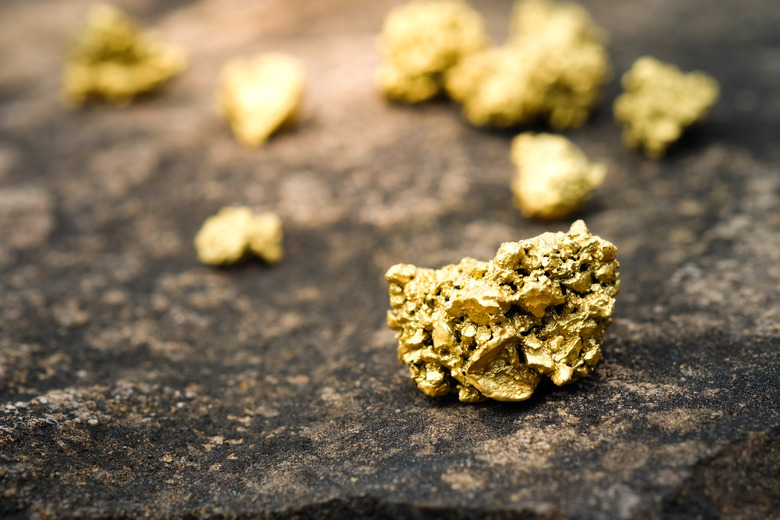Causes Of Gold Discoloration
Ever found a gold ring that had turned a copper color and wondered why? Gold jewelry discolors over time because it is not pure gold. The gold itself typically does not change, but it is the other components that tarnish over time. Discoloration of gold may also be caused by poor gold-plating techniques where the gold layer is too thin and eventually, through friction, it is worn off, revealing the base material.
Can Gold Discolor?
Can Gold Discolor?
Gold is a tarnish-resistant metal, so it will not discolor. This is because gold has a low reactivity rating. In chemistry, reactivity describes how likely an element is to lose electrons and form positive ions. The more likely this is to happen, the more reactive an element is.
To test how reactive an element is, chemists expose it to water, acids and steam. For example, when an element with high reactivity, like potassium metal, is placed in water, it quickly reacts, producing hydrogen gas and enough heat to ignite in the right quantities. On the other hand, when gold, which has low reactivity, is placed in water, steam or baths of dilute acids, it will not react.
Discoloration of Gold Alloys
Discoloration of Gold Alloys
Though the chemical nature of gold will not discolor, gold alloys will discolor and at different rates depending on the blend. For example, silver, copper, iron, zinc and aluminum are commonly added to gold in varying percentages to create different gold alloys. These metals have higher reactivity ratings than gold, meaning they more quickly discolor. In chemistry, this reaction when metals are mixed is called displacement.
Oxidation is another chemical reaction that can cause discoloration in gold alloys. When metal oxidizes, it loses electrons as it is exposed to oxygen. Again, because pure gold has a low reactivity, it is highly unlikely to oxidize, but the other metals in gold alloys will.
Why Use Gold Alloys?
Why Use Gold Alloys?
By itself, gold is a very soft metal, which makes it challenging to use for practical applications. Although they can discolor over time, gold alloys have the benefits of strengthening gold, creating an array of colors and altering the value. The higher the gold percentage in an alloy, commonly indicated by its karat value, the longer it will take to discolor. Though most gold alloys will tarnish over time, proper care and polishing can restore them to their original luster.
Gold Tarnish Colors
Gold Tarnish Colors
Tarnish spots on gold are often red, brown or black. Though tarnish spots were once thought possible on ancient pure gold artifacts, contrast microscopy and laser scanning revealed that these spots are the result of nanometer-thick films of other elements such as silver or sulfur. A piece of gold may be covered in several different types of these impurity particles and produce different tarnish spot colors.
Silver and gold are a typical alloy mix and popular as they produce a "true" gold color. Gold turning purple may result from silver tarnishing to produce silver chloride, which is a combination of binary silver salts and chlorine. When silver sulfide is made, it causes a black tarnish.
Tarnished Gold Plating
Tarnished Gold Plating
Gold plating is when a thin layer of gold is chemically bonded to a base metal using electricity. For high-quality gold plating, this process is repeated several times to build up multiple layers of gold. Proper gold-plating techniques use pure gold, preventing tarnishing as the base metal with a higher reactivity is not exposed to the elements. In this instance, it is only when the base metal is exposed that discoloration will occur.
Poor-quality plating using a low-grade gold alloy typically results in thinner or improperly bonded layers that wear away and allow the base metal to rapidly tarnish. Discoloration caused by exposed base metals can be restored by replating the object. Replating may also help restore poorly plated items. However, this can prove more difficult due to the more complex chemical nature of gold alloys.
Cite This Article
MLA
Jerrett, Adrianne. "Causes Of Gold Discoloration" sciencing.com, https://www.sciencing.com/causes-gold-discoloration-6158003/. 20 October 2021.
APA
Jerrett, Adrianne. (2021, October 20). Causes Of Gold Discoloration. sciencing.com. Retrieved from https://www.sciencing.com/causes-gold-discoloration-6158003/
Chicago
Jerrett, Adrianne. Causes Of Gold Discoloration last modified March 24, 2022. https://www.sciencing.com/causes-gold-discoloration-6158003/
